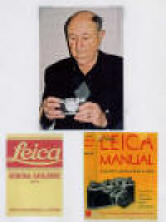The Leica Freedom Train
When Andreas Heinsius, a Shanghailander who spent his youth in the Shanghai Ghetto, bought a Leica camera for his Dad’s birthday in 1953 while serving in the US Army in Germany, no one would have thought that fifty plus years later, the designer and manufacturer of that camera, Ernst Leitz, was going to be honored by the news media, not for his company’s product but rather, for having taken part in an important humanitarian cause. Shown on a recent photograph is Andreas, the son of the late Bruno Heinsius holding one of the very popular Leica cameras.
We have learned in times that a past event usually
unfolds many years after it happened, and so did the heartwarming story
of how this industrial giant, Ernst Leitz saved many Jews from the
Holocaust. Thanks to George Gilbert, a thirty year veteran writer for
the popular Photographic Press, the tale of courage and integrity of the
designer and manufacturer of Germany’s most famous photographic products
is only now coming to light seventy years later.
 Like
Andreas’s parents who were desperately seeking a way to escape from Nazi
persecution in Germany during the late 30’s, so were a large number of
Leica’s Jewish employees trying to get out of the country. This was a
time when most countries had closed their doors to stateless Jews
wanting to emigrate to wherever they could. To help his Jewish workers
and colleagues, Leitz established confidentially with his top executives
abroad what has become known among historians of the Holocaust as the "Leica Freedom Train," a covert means of allowing
Jews to leave Germany under the pretext, Leitz employees being assigned
overseas.
Like
Andreas’s parents who were desperately seeking a way to escape from Nazi
persecution in Germany during the late 30’s, so were a large number of
Leica’s Jewish employees trying to get out of the country. This was a
time when most countries had closed their doors to stateless Jews
wanting to emigrate to wherever they could. To help his Jewish workers
and colleagues, Leitz established confidentially with his top executives
abroad what has become known among historians of the Holocaust as the "Leica Freedom Train," a covert means of allowing
Jews to leave Germany under the pretext, Leitz employees being assigned
overseas.
Keeping the story quiet, the Leica Freedom Train was at its height in 1938 and early 1939, delivering groups of refugees to New York every few weeks where the management at the Manhattan office of Leitz Inc. placed them in jobs within the photographic industry.
People asked why no one had told the story until now. According to Gilbert, who had over 400 articles related to photography published to his credit in various magazines and journals, the story of the Freedom Train program was first proposed to the popular Readers Digest. Leitz’s directors regretfully refused permission to have the story published on grounds that if people that were involved in the project were still alive, they could be subject to potential risk or retaliation.
Finally in 1987 the last person that may have supported and been involved in this heroic deed of Ernst Leitz had died, thus an article by George Gilbert about the Freedom Train began to appear in various photographic chronicles.
On a personal footnote, Andreas Heinsius fled with his parents and maternal grandmother in the late 30’s from the Nazis in Germany to Shanghai. His sister, Brenda was born after they arrived. After the war, the family emigrated to America and settled in southern California where Andreas’s father set up his own work shop producing lamp shades with his wife Greta. Both his parents deceased; Andreas is today enjoying his retirement from the post office with his wife and family.
References:
§
The Hidden
Leica Story by George Gilbert
§
Illustrated World Wide Who’s Who of Jews in Photography.
§ An
explanation in Rabbi Smith’s 2002 pamphlet, The Leica Freedom Train,
published by the
American Photographic Historical Society in NY.